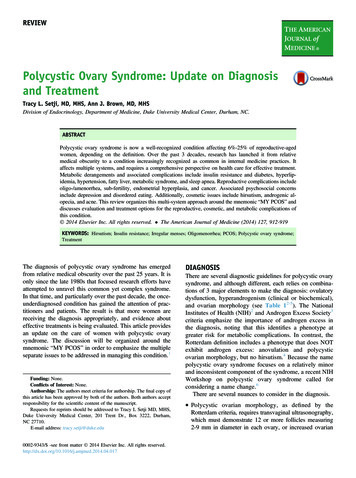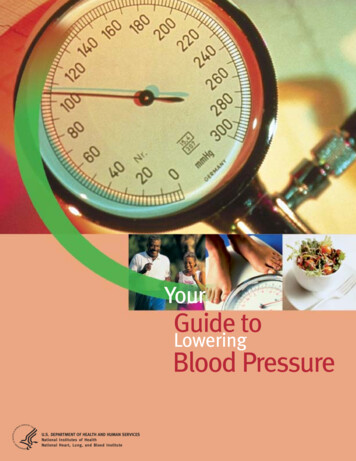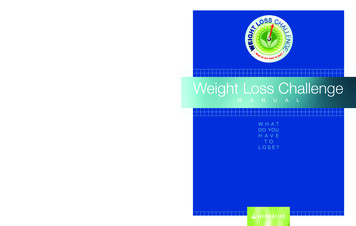
Transcription
Chapter 9Weight Control:Overweight andUnderweight
Please do not use yourcell phone duringclass!!
Obesity StatisticsAccording to the Center for Disease Control: Approximately69-70% of adult Americans areconsidered overweight or obese based onhaving a BMI 25 Approximately 34% of adult Americans areclinically obese with BMI 30 There has been a 61% increase in US adultobesity from 1991 to 2000 This coincides with a 49% rise in Type 2Diabetes among adult Americans According to the WHO, obesity affects 1.9billion adults worldwide. 41 million children under the age of 5 areoverweight or obese
Increasing Prevalence of Obesityamong US Adults
Increasing Prevalence of ObesityAmong US Adults
Fat Cell Development Energy in Energy out Stored Energy Amount of fat reflects both number and size offat cellsThe number of fat cells increases during growingyears of childhood and pubertyObesity occurs when your fat cells increase innumbers, size, or both Stored in fat cell of adipose tissueObese people have more fat cells and larger onesEnergy out Energy in decrease in fat cell size, but not number
Fat Cell DevelopmentDuring growth,fat cells increasein number.When energy intakeexceeds expenditure,fat cells increase in size.When fat cells have enlargedand energy intake continues toexceed energy expenditure, fatcells increase in number again.With fat loss, the size ofthe fat cells shrinks, butnot the number.Fat cells are capable of increasing their size by20-fold and their number by several thousand fold.
Overweight and Obesity Hyperplastic ObesityIncrease in the number of fat cells Hypertrophic ObesityIncrease in the size of the fat cells
Excess fat fill adiposetissue first Additional excess isdeposited in organssuch as heart and livercalled ectopic fat. Ectopic fat disruptsmetabolism andcontributes to heartdisease and fatty liver
Fat Cell Development1.2.3.4.5.Fat is stored in tissue.The number and of fat cellsincreases when energy balance ispositive.As fat cells enlarge, it stimulate cell, meaning the number of cellsincreases.If energy balance becomes negative,the number of fat cells remains thesame/decreases.fat disrupts normal metabolismand contributes to disease.Answer:1. Adipose2. Size3. Proliferation4. Remains thesame5. EctopicExplanation:Fat is stored when“energy in” is greaterthan “energy out.”Even with weightloss, the size of fatcells shrink, but thenumber doesn’tchange.
Fat Cell Metabolism Lipoproteinlipase (LPL)- enzymemounted on fat cell membranes Removes triglyceride from thebloodstream Promotes fat storage in adipose andmuscle cells The more fat cells, the more LPLactivity so obese people have more LPL activity Thehigher the LPL activity, the moreefficient at storing fat
“Apple” and “Pear” Body Shapes ComparedMen havehigher LPLactivity in theabdomenWomen havehigher LPL activityin hips, breasts,thighs
Fat Cell Metabolism Afterweight loss, adipose LPL activityincreases More so in those that were heaviest prior toweight loss Thisexplains why people regain theirweight loss so easily
Set Point Theory Aftera weight gain or weight loss, thebody adjusts its metabolism to restore theoriginal weight Regulatory centers constantly monitor andadjust conditions to maintain homeostasisThe body tends to maintain a certainweight by its own internal controls
Causes of Overweight andObesity EnergyIn Energy Out Genetic? Environmental? Cultural? Behavioral? Socioeconomic? Psychological? Metabolic? All of the above?
Causes of Obesity- GeneticsGenetics: Both parents obese: 80% chance child will be obese Both parents not obese: 10% chance child obese Adopted child: Similar weight to biological parents Twin Studies: Identical twins are twice as likely toweigh same as fraternal twins. (Even if rearedseparately.) Identical twins may become different over time asenvironmental factors influence them Geneticsplays a role in susceptibility to obesity
Nutritional Genomics Nutrigenetics-howgenes influence theactivities ofnutrients. Nutrigenomics-hownutrients influencethe activities of thegenesBoth mice have the gene that tendsto make fat, yellow pups, but themoms had different diets. Themother of the mouse on the rightreceived a supplement whichsilenced the gene, resulting inbrown pups with normal appetites.
Causes of Overweight and ObesityGeneticsObesity Gene (ob) Expressed in the adipose tissue and codes for theprotein Leptin. Acts as a hormone in the hypothalamus to:Increase energy expenditureDecrease appetiteAlso released from stomach cells in response to foodServes as an internal controlGenetic deficiency is rare
Mice with and without Leptin ComparedWithout leptin, this mouse weighsalmost three times as much as anormal mouse.With leptin treatment, this mouse losta significant amount of weight, but stillweighs almost one and a half times asmuch as a normal mouse.
GeneticsGhrelin: Produced in stomach cells Acts as a hormone in hypothalamus Triggers the desire to eat Increases smell sensitivityStimulates appetitePromoting energy storage Increaseswith lack of sleep
Causes of Obesity – Genetics& Epigenetics
Causes of Obesity-EnvironmentOvereating Bothpresent and past eating habits influencecurrent body weight Our environment-Food is everywhere! High calorie, high fat, readily available, cheap, heavilyadvertised, tasty, convenientSupersizing” to get a better value offers much morefood than is neededFast food is often high in fatFat Intake: High fat diet promotes obesityFood industry spends 30 billion per year on advertising
A large portion of fries delivers500 calories and 25 grams of fatMcDonald's(USA) serves 27million peopleevery day, 1million moreevery year since2003
In and Out BurgerDouble-Double at In and Out is670 calories, 41 grams of fatFrench fries are 400 caloriesand 18 grams of fat
CostcoMuffin Blueberry: 610 kcalories 32 grams fat Chocolatechip 690 kcalories 38 grams fat
Causes of Obesity -EnvironmentPhysical Inactivity: Major contributor toobesity Modern technology has replaced physicalactivity at home, work, and transportation Inactivity contributes to weight gain andpoor health TV, Video games, computers Require little energy Replace time spent in vigorous activity TV influences food purchases andbetween meal snacking
Causes of Obesity- EnvironmentPhysical Inactivity: Major contributor toobesity Obesity may be related to “moving too little”,not just overeating DRIrecommends an accumulation of 60 minutesof moderately intense exercisedaily to prevent weight gain inaddition to activities of dailyliving.
Problems with Obesity Anestimated 59% of all U.S. adults aretrying to lose weight at any given time Up to 33 billion dollars a year is spenton weight control Obesity problems depend on manyfactors such as the extent ofoverweight, age, health status andgenetic makeup. Risk factors may differ amongindividuals.
Problems with Obesity Healthrisks are evaluated using 3 Indicators: HealthRisks Indicators BMI ( 25 overweight, 30 obese) Waist Circumference 35for women 40 for men Diseaserisk profile; family history, life-threateningdiseases, risk factors for disease Overweightpeople who are in good health maynot benefit from weight loss
Health RisksWho Needs Treatment? Peoplewho are obese or overweight people (orwith a high waist circumference), with 1 or morerisk factors require treatment for weight loss. Risk factors include: Hypertension Cigarettesmoking High LDL or Low HDL Family history of heart disease Diabetes or Pre-diabetes Men 45 years, women 55 years
Problems with ObesityWho Needs Treatment? Health RisksObese or overweight people with thefollowing life-threatening-conditions requireaggressive treatment. Heartdisease Type 2 diabetes Sleep apnea
Problems with Obesity Perceptions and PrejudicesSocial ConsequencesPrejudices and discrimination Judged on appearance rather than character Stereotyped Psychological ProblemsFeelings of rejection, embarrassment anddepression are common. Ineffective treatments can lead to a sense offailure.
The Psychology of Weight Cycling
Dangerous InterventionsFad Diets:Popular eating plans thatpromise quick weight loss
How to Identify a Fad Diet Overemphasizesone food group or single nutrient. Does not teach controlled eating or sensible mealplanning. Promises quick and easy weight loss Eliminates an entire food group Can be dangerous as they often restrict or eliminatenecessary nutrients. Requires you to buy special foods Claims to reset your genetic code Fails to mention risks
Table H9-2a, p. 307
Dangerous InterventionsDietary supplements do not require FDA approvalManufacturers do not need to test the safety of effectivenessSo many promises, so little success.
Table 9-3, p. 281
Problems with Obesity DangerousInterventions Weight-LossProducts Ephedrine Banned by the FDA due to potential health risks.Implicated in heart attacks, seizures, and about 100 deaths Dieters tea-Herbal laxatives do not prevent absorptionCause nausea, vomiting, diarrhea, crampingDeath of 4 women Currentlaws do not require manufacturers to conductsafety and effectiveness tests for these products. Not regulated by the FDA.
Dangerous InterventionsOTC Supplements Whatis Hoodia? Succulent plant grown in South Africa Chemical in it called P57 that is thought to act onthe hypothalamus to trigger satiety 13 types of hoodia plants; only hoodia gardoniicontains the chemical NO published randomized, controlled clinicaltrials in humans Do not use if you have diabetes, heart disease,hypertension, pregnancy or lactating
Dangerous InterventionsOTC Supplements What happened to Hydroxycut?FDA recalled it in May 200923 reported cases of serious liver injuries Including2007 death of 19 year old male Liver failure, jaundice, seizures, cardiovascularproblems Symptoms include: brown urine, nausea,fatigue, stomach pain, itching
OTC SupplementsGarcinia Gambogia Made from the tamarind fruitRaises serotonin and decreases appetiteResearch is limited- patients only lost 2 #Side effects include: dizziness, dry mouth, headache,upset stomach or diarrheaMay interfere with the following drugs: Asthma and allergy medicines such as SingulairDiabetes medicines, including pills and insulinIron, for anemiaPain medicinesPrescriptions for psychiatric conditionsStatins, drugs that lower cholesterolWarfarin, a blood thinner
OTC SupplementsLipozene Theactive ingredient in Lipozene isglucomannan, a complex carbohydratefound in the konjac plant. Glucomannan is an insoluble fiber it absorbs water to form a thick gel that coatsthe stomach, making you feel full—thusreducing your eating.
Other GimmicksOther Gimmicks Don’t work:Creams, wraps, belts, massages, steam,saunas DON’T MELT OFF THE FATAfter drying off from yourshower, generously applythe hemorrhoid cream to thecellulite afflicted area.After applying the cream,wrap the area with plasticwrap.
CelluliteCelluliteFatty areas of the body that appear lumpy whenthe connective tissue that attach the skin to theunderlying muscles pull tight where the fat isthick Cellulite is caused by fibrousconnective cords that connect theskin to the underlying muscle. Thecords tether the skin to deeperstructures, with the fat lying inbetween. As the fat cellsaccumulate, they push up againstthe skin, while the long, tough cordsare pulling down. This creates anuneven surface or dimpling.
FDA-Approved Drugs for WeightLossOrlistat (OR-leh-stat),trade names: Alli,XenicalInhibits pancreaticlipase activity in the GItract, thus blockingdigestion andabsorption of dietary fatand limiting energyintakeGI cramping, diarrhea, gas, frequent bowelmovements, reduced absorption of fatsoluble vitamins; rare cases of liver injuryPhentermine (an appetitesuppressant) andtopiramate (aseizure/migrainemedication) combination,trade name: Qsymia(kyoo-sim-EE-uh)Enhances the releaseof the neurotransmitternorepinephrine, whichsuppresses appetite,and increases thefeeling of being full,making foods tasteless appealingIncreased heart rate; can cause birth defectsif takenin the first weeks or months of pregnancy;suicidal thoughts; may worsen glaucoma andother eye Problems
FDA-Approved Drugs for Weight LossDrugActionSide EffectsBupropion (anantidepressant andsmoking cessation drug)and naltrexone (an opioidreceptor antagonist usedfor alcohol and drugabuse) combination, tradename: ContraveIncreases metabolism,suppresses appetiteNausea, increased heart rate and bloodpressure, suicidal thoughtsLiraglutide, trade name:SaxendaActs like a hormone tocontrol blood glucose,suppresses appetiteNausea, diarrhea, constipation, vomiting, lowblood glucose, increased heart rate,pancreatitis, gallbladder disease, suicidalthoughtsLorcaserin (lor-ka-SER-in)hydrochloride, tradename: Belviq (BELL-veek)Interacts with brainserotonin receptors toincrease satiety andreduce food intakeHeadache, dizziness, fatigue, nausea, drymouth, and constipation; low blood glucose inpeople with diabetes; serotonin syndrome,including agitation, confusion, fever, loss ofcoordination, rapid or irregular heart rate,shivering, seizures, and unconsciousness;cannot be safely used by pregnant or lactatingwomen or people with heart-valve problems;high doses cause hallucinations
FDA-Approved Drugs for Weight LossDrugActionSide EffectsOrlistat (OR-leh-stat), tradenames: Alli,XenicalInhibits pancreatic lipase activity in theGI tract, thus blocking digestion andabsorption of dietary fat and limitingenergy intakeGl cramping, diarrhea, gas, frequent bowelmovements,reduced absorption of fat-soluble vitamins; rarecases ofliver injuryIncreased blood pressure and heart rate, insomnia,nervousness, dizziness, headachePhentermine (FEN-termean), diethylpropion (DYE-ethill-PRO-pee-on). phendimetrazine(FEN-dye-MEH-tra-zeen)Lorcaserin hydrochloride, tradename: Belviq (BELL-veek)Enhances the release of theneurotransmitternorepinephrine, which suppressesappetiteInteracts with brain serotonin receptors Headache, dizziness, fatigue, nausea, dry mouth, andtoconstipation; low blood glucose in people withincrease satiety and reduce food intake diabetes;serotonin syndrome, including agitation, confusion,fever,loss of coordination, rapid or irregular heart rate,shivering, seizures, and unconsciousness; cannot besafely used by pregnant or lactating women orpeople with heart-valve problems; high doses causehallucinationsPhentermine (an appetiteEnhances the release of theIncreased heart rate; can cause birth detects if takensuppressant) and topiramate (aneurotransmitterinseizure/migraine medication)norepinephrine, which suppressesthe first weeks or months of pregnancy; increasedcombination, trade name: Qsymia appetite,heart(kyoo-sim-EE-uh)and increases the feeling of being full,rate; suicidal thoughts; may worsen glaucoma andmakingotherfoods taste less appealingeye problemsNOTE: Weight-loss drugs are most effective when taken as directed and used in combination with reduced-kcalorie diet and increasedphysical activity
Aggressive Treatments of Obesity Surgery 200,000performed annually Surgery is an option for those: Unsuccessfulin weight loss programs BMI 35 with a weight related health problem Have a BMI 40 No medical or psychologicalcontraindications Understanding of risks and strong potential forcompliance
Gastric Surgery Reducesthe capacity of the stomach Suppresses hunger by reducingproduction of the hormone ghrelin Lose 20-32% of body weight Improvement in diabetes, blood lipids,and blood pressure Complications include nausea, vomiting,dehydration, diarrhea Potential for deficiencies of Iron, B12,Calcium, Folate and Vitamin D Requires lifelong medical supervision
Gastric Surgery Used in the Treatment of Severe ObesitySleeve gastrectomy. During this procedurea bariatric surgeon removes about 85percent of the stomach so that it takes theshape of a tube or sleeve. It is not reversible.Advantages:Early satiety sensation.No /how-it-works
Duodenal SwitchIdeal Candidate: Has BMI 60 kg/m2 orsevere diabetes Patients with poorlycontrolled diabetes orinsulin-dependent diabeteshave the highest cure ratewith this procedure
Weight Loss Strategies Successful strategiesSmall changes and moderate lossesReasonable goals ½-2 pounds per week 10% loss of initial body weight by six monthsand maintained for 1 year Incorporation of healthy eatingPhysical activityPermanent lifestyle changes
Weight-Loss Strategies Eating BePatternsRealistic about Energy Intake 500-1000kcalories/day reduction 1200 -1500 kcalories for women 1500-1800 for men Eat breakfast Nutritionally Difficultadequateto achieve on less than 1200 kcaloriesa day May need a supplement Smallerportions
Weight-Loss Strategies Eating PatternsEat slowlyLower energy densityWater Increases fullness and reduce hunger.Focus on fiber Fresh fruit, vegetables, whole grains Provide vitamins, minerals and fiber with littlefat.Choose fats sensiblySelect Carbohydrates CarefullyAvoid empty kcalories from sugar and alcohol.
Daily Amounts from Each FoodGroup
Weight-Loss StrategiesLower energy densityHigh in fiber, high in water and low in fat.
A 16 oz cafe mochadelivers 400 kcalories, ½of them from fatp. 298
Weight-Loss StrategiesFood To maintain weight, consume foods and drinksto meet, not exceed, kcalorie needs. To loseweight, energy out should exceed energy in byabout 500 kcalories/day.Emphasize foods with a low energy density anda high nutrient density; make legumes, wholegrains, vegetables, and fruits central to yourdiet plan. Eat slowly. Drink water before you eat and while you eat;drink plenty of water throughout the day. Track food and kcalorie intake. Plan ahead to make better food choices. Limit kcalorie intake from solid fats and addedsugars. Reduce portions, especially of high- kcaloriefoods. Cook and eat more meals at home, instead ofeating out. When eating out, think aboutchoosing healthy options.Activities Limit screen time. Increase physical activity. Choose moderate- or vigorous-intensity physicalactivities. Avoid inactivity. Some physical activity is better thannone. Slowly build up the amount of physical activity youchoose.
Weight Loss Strategies –Physical Activity Bestapproach to weight managementincludes: Moderate physical activity plus activities of daily life Combination of diet and physical activityLose more fatRetain more muscleRegain less weight Reductionof abdominal fat
Weight-Loss StrategiesPhysical Activity Activityand energy expenditureA 150# man walking 3 ½ miles in 60 minutes burnsabout the same as running 3 miles in 30 minutesActivity and Metabolism Metabolic rate increasesHelps develop more lean body tissue Activity and Body CompositionLean mass increases, fat decreases Activitymay help to curb appetite. Activity can reduce stress and improve selfesteem.
Weight-Loss Strategies PhysicalActivity ChoosingActivities Chooseactivities that you Low to moderate intensity for long duration isrecommended. Daily routines can incorporate energyactivities. SpotReducing Aerobicexercise helps with abdominal fat Strength training can improve muscle tone. Stretching can help flexibility.
Weight Loss Strategies Environmental ctionsMultiple choicesPackage and portion sizeServing containers
Weight-Loss StrategiesBehavior and Attitude BehaviorModification Awarenessof behavior is the first key Changing behaviors one at a timeworks best. Donot grocery shop when hungry. Eat slowly. Exercise while watching television. Smaller plate Becomeaware of your personalattitudes toward food Support groups may be helpful for somepeople.
Secrets of Successful Losers:Weight Maintenance Vigorous exercise (2500 kcalories weekly))60 minutes of moderate activity daily Consumereduced kcalorie diet, small portions Eat breakfast Frequent self-monitoring Limit TV to less than 10 hours per week Lifestyle change Develop good coping skills Reviewof the research studies suggest that only20% of people who intentionally lose weight areable to maintain it for 5 years
Weight-Loss Strategies Preventionis the beststrategy for weight control Eat regular meals and limit snacking.Drink water in place of high-kcalorie beverages.Select sensible portion sizes and limit dailyenergy intake to energy expended.Limit sedentary activities and be physicallyactive.
National Strategies to Prevent Obesity Provide a variety of opportunities to help make physical activity anintegral and routine part of life. Create environments that ensure healthy foods and beverages are visible,attractive, and easy-to-obtain. Encourage media messages that promote physically active lifestyles andnutritionally healthy diets. Support health care providers in offering information on weightmanagement andemployers in offering wellness programs. Make schools centers for health and wellness.SOURCE: Accelerating Progress in Obesity Prevention: Solving theWeight of the Nation, (Washington. DC: Institute ofMedicine of the National Academies). 2012.
UnderweightWeight Gain Strategies Energy-dense Regularfoodsmeals Large portions--Extra cheese, larger glassor bowl Snacks Beverages-Juices, Milk Exercise-strength training
End of Chapter 9
Fat Cell Development When fat cells have enlarged and energy intake continues to exceed energy expenditure, fat cells increase in number again. During growth, fat cells increase in number. When energy intake exceeds expenditure, fat cells increase in size. With fat loss, the size of th










